@Controller和@RestController源码解析
2018年不知不觉已经走到了尾声,你还在为分不清@Controller和@Restcontroller而烦恼吗?这篇博文从源码层面分析这两个注解,值得一读。
首先贴一张源码的图,对比一下,左边是@Controller的源码,右边是@RestController的。

如果觉得不清楚,看下面代码:
@Controller:
@Target({ElementType.TYPE})
@Retention(RetentionPolicy.RUNTIME)
@Documented
@Component
public @interface Controller {
/**
* The value may indicate a suggestion for a logical component name,
* to be turned into a Spring bean in case of an autodetected component.
* @return the suggested component name, if any (or empty String otherwise)
*/
@AliasFor(annotation = Component.class)
String value() default "";
}
@RestController:
@Target(ElementType.TYPE)
@Retention(RetentionPolicy.RUNTIME)
@Documented
@Controller
@ResponseBody
public @interface RestController { /**
* The value may indicate a suggestion for a logical component name,
* to be turned into a Spring bean in case of an autodetected component.
* @return the suggested component name, if any (or empty String otherwise)
* @since 4.0.1
*/
@AliasFor(annotation = Controller.class)
String value() default ""; }
显然,两个注解的源码里面都包含许多的注解:
@Controller的注解包括:@Target({ElementType.TYPE})、@Retention(RetentionPolicy.RUNTIME)、@Documented、@Component
@RestController的注解包括:@Target(ElementType.TYPE)、@Retention(RetentionPolicy.RUNTIME)、@Documented、@Controller、@ResponseBody
所以,源码的分析也就是对注解的分析。
内置注解和元注解
注解(也被称为元数据)为我们在代码中添加信息提供了一种形式化的方法,使我们可以在稍后某个时刻非常方便地使用这些数据。
Java SE5中有三种内置注解:
|
@Override
|
表示当前的方法定义将覆盖超类中的方法
|
|
@Deprecated
|
如果程序中使用了注解为它的元素,那么编译器会发出警告
|
|
@SuppressWarnings
|
关闭不当的编译器警告信息
|
| @Target |
表示该注解可以用于什么地方。可能的ElementType参数包括:
CONSTRUCTOR:构造器的声明
FIELD:域声明(包括enum实例)
LOCAL_VARIABLE:局部变量声明
METHOD:方法声明
PACKAGE:包声明
PARAMETER:参数声明
TYPE:类、接口(包括注解类型)和enum声明
|
| @Retention |
表示需要在什么级别保存该注解信息。可选的RetentionPolicy参数包括:
SOURCE:注解将在编译器丢弃
CLASS:注解在class文件中可用,但会被VM丢弃
RUNTIME:VM将在运行期也保留注解,因此可以通过反射机制读取注解的信息
|
| @Documented | 将此注解包含在Javadoc中 |
| @Inherited | 允许子类继承父类中的注解 |
现在,明白了@Target({ElementType.TYPE})、@Retention(RetentionPolicy.RUNTIME)、@Documented的作用,我们也可以自定义一个注解@Algorithms:
/**
*
* Define a annotation named Algorithms
*
*/
@Target(ElementType.TYPE)
@Retention(RetentionPolicy.SOURCE)
public @interface Algorithms {
String value() default "";
}
@Component注解
@Component注解源码如下:
@Target(ElementType.TYPE)
@Retention(RetentionPolicy.RUNTIME)
@Documented
@Indexed
public @interface Component { /**
* The value may indicate a suggestion for a logical component name,
* to be turned into a Spring bean in case of an autodetected component.
* @return the suggested component name, if any (or empty String otherwise)
*/
String value() default ""; }
加了@Component注解,表明这是一个逻辑组件,告知Spring要为它创建bean。相当于xml配置文件中的 <bean id="" class=""/>的作用。
@AliasFor注解
@AliasFor注解是一个用于声明注解属性别名的注解,源码如下:
@Retention(RetentionPolicy.RUNTIME)
@Target(ElementType.METHOD)
@Documented
public @interface AliasFor { /**
* Alias for {@link #attribute}.
* <p>Intended to be used instead of {@link #attribute} when {@link #annotation}
* is not declared — for example: {@code @AliasFor("value")} instead of
* {@code @AliasFor(attribute = "value")}.
*/
@AliasFor("attribute")
String value() default "";
/**
* The name of the attribute that <em>this</em> attribute is an alias for.
* @see #value
*/
@AliasFor("value")
String attribute() default "";
/**
* The type of annotation in which the aliased {@link #attribute} is declared.
* <p>Defaults to {@link Annotation}, implying that the aliased attribute is
* declared in the same annotation as <em>this</em> attribute.
*/
Class<? extends Annotation> annotation() default Annotation.class; }
@Controller中的@AliasFor(annotation = Component.class)说明@Controller是Component的一个别名,本质上还是一个Component,正如注释中所说“to be turned into a Spring bean in case of an autodetected component.”,可以被扫描成一个bean。
同理,@RestController中的@AliasFor(annotation = Controller.class)说明@RestController是Controller的一个别名,是一个Controller,再本质一点说,是个Component,是个Spring bean。
@ResponseBody注解
@Target({ElementType.TYPE, ElementType.METHOD})
@Retention(RetentionPolicy.RUNTIME)
@Documented
public @interface ResponseBody {
}
提到@ResponseBody注解,就不得不提一个名词:表述性状态转移(Representational State Transfer,REST)。
什么是表述性状态转移呢?拆开来看:
表述性:REST资源实际上可以用各种形式来表述,包括JSON、XML、HTML等;
状态:使用TEST的时候,我们更关注资源的状态而不是对资源采取的行为;
转移:以某种形式(例如JSON)从一个应用转换到另一个应用,例如从服务器到客户端。
简单讲,REST就是将资源的状态以最适合客户端或者服务器的形式从服务器转移到客户端(或者反过来)。
在Spring 4.0版本中,Spring支持借助@ResponseBody注解和各种HttpMethodConverter,替换基于视图的渲染方式,实现对REST的支持。当然Spring对REST的支持远不止这一种方式。
@ResponseBody注解告知Spring,要将返回的对象作为资源发送给客户端。这个过程跳过正常的模型/视图流程中视图解析的过程,而是使用Spring自带的各种Http消息转换器将控制器产生的数据转换为客户端需要的表述形式。如果客户端请求头的Accept表明他能接受“application/json”,并且Jackson JSON在类路径下面,那么处理方法返回的对象将交给MappingJacksonHTTPMessageConverter,并由他转换为JSON返回给客户端;如果客户端想要“text/html”格式,那么Jaxb2RootElementHttpMessageConverter将会为客户端产生XML响应。
当处理请求时候,@ResponseBody和@RequestBody是启用消息转换的一种简介和强大方式。但是,如果控制器里面的每个方法都需要信息转换功能的话,那么这些注解就会带有一定程度的重复性。
所以,Spring 4.0引入了@RestController注解,如果在控制器类上面使用@RestController注解,我们不必再为每个方法添加@ResponseBody注解,因为Spring会为该控制器下面的所有方法应用消息转换功能。这也是这个Controller之所以叫RestController的原因,正所谓见名知意。
总结
@RestController相当于@ResponseBody + @Controller一起作用。
如果控制器产生的结果希望让人看到,那么它产生的模型数据需要渲染到视图中,从而可以展示到浏览器中,使用@Controller。
如果控制器产生的结果不需要让人看到,那么它产生的数据经过消息转换器直接返回到浏览器,使用@RestController。
参考文献:
[1] Bruce Eckel. Java编程思想(第四版)[M]. 陈昊鹏译. 北京:机械工业出版社,2007.
[2] Craig Walls. Spring实战(第4版)[M]. 张卫滨译. 北京:人民邮电出版社,2016.
@Controller和@RestController源码解析的更多相关文章
- @GeneratedValue源码解析
JPA要求每一个实体必须有且只有一个主键,而@GeneratedValue提供了主键的生成策略,这就是@GeneratedValue注解存在的意义.本文将浅析@GeneratedValue的源码. @ ...
- 实战录 | Kafka-0.10 Consumer源码解析
<实战录>导语 前方高能!请注意本期攻城狮幽默细胞爆表,坐地铁的拉好把手,喝水的就建议暂时先别喝了:)本期分享人为云端卫士大数据工程师韩宝君,将带来Kafka-0.10 Consumer源 ...
- Heritrix 3.1.0 源码解析(三十七)
今天有兴趣重新看了一下heritrix3.1.0系统里面的线程池源码,heritrix系统没有采用java的cocurrency包里面的并发框架,而是采用了线程组ThreadGroup类来实现线程池的 ...
- PureMVC(JS版)源码解析:总结
PureMVC源码中设计到的11个类已经全部解析完了,回首想想,花了一周的时间做的这点事情还是挺值得的,自己的文字组织表达能力和对pureMVC的理解也在写博客的过程中得到了些提升.我也是第一次写系列 ...
- PureMVC(JS版)源码解析
PureMVC(JS版)源码解析:总结 PureMVC源码中设计到的11个类已经全部解析完了,回首想想,花了一周的时间做的这点事情还是挺值得的,自己的文字组织表达能力和对pureMVC的理解也在写 ...
- spring MVC cors跨域实现源码解析
# spring MVC cors跨域实现源码解析 > 名词解释:跨域资源共享(Cross-Origin Resource Sharing) 简单说就是只要协议.IP.http方法任意一个不同就 ...
- springMVC源码解析--ViewResolver视图解析器执行(三)
之前两篇博客springMVC源码分析--ViewResolver视图解析器(一)和springMVC源码解析--ViewResolverComposite视图解析器集合(二)中我们已经简单介绍了一些 ...
- .Net Core缓存组件(Redis)源码解析
上一篇文章已经介绍了MemoryCache,MemoryCache存储的数据类型是Object,也说了Redis支持五中数据类型的存储,但是微软的Redis缓存组件只实现了Hash类型的存储.在分析源 ...
- .Net Core缓存组件(MemoryCache)源码解析
一.介绍 由于CPU从内存中读取数据的速度比从磁盘读取快几个数量级,并且存在内存中,减小了数据库访问的压力,所以缓存几乎每个项目都会用到.一般常用的有MemoryCache.Redis.MemoryC ...
随机推荐
- asp.net路径问题
-------------初级篇---------------------------------------- 在一般的href中路径的引用问题 ./index.aspx与index.aspx都 ...
- meta的用法
META标签,是HTML语言head区的一个辅助性标签.在几乎所有的page里,我们都可以看 到类似下面这段html代码: -------------------------------------- ...
- 终于解决文件格式问题 unix格式
关于这个问题,今天终于找到方法 file-setting下 左侧code style line separator下拉选择unix就可以了 http://www.cnblogs.com/sunfa ...
- 填坑!!!virtualenv 中 nginx + uwsgi 部署 django
一.为什么会有这篇文章 第一次接触 uwsgi 和 nginx ,这个环境搭建,踩了太多坑,现在记录下来,让后来者少走弯路. 本来在 Ubuntu14.04 上 搭建好了环境,然后到 centos7. ...
- 【Service Fabric】小白入门记录 本地Service Fabric集群安装及设置
本篇内容是自学自记,现在我还不知道Service Fabric究竟是怎么个入门法,反正按照入门教程先进行本地Service Fabric集群的安装,万里路始于足下,要学习总得先把环境装好了才能开始学习 ...
- SQL关于IN和EXISTS的用法和区别的比较
1.exist,not exist一般都是与子查询一起使用. In可以与子查询一起使用,也可以直接in (a,b.....).2.exist会针对子查询的表使用索引. not exist会对主子查询都 ...
- CKEditor、UBB编辑器的使用总结
2018-04-08 22:07:16.188 ERROR 14728 --- [nio-8082-exec-8] o.a.c.c.C.[.[.[/].[dispatcherServlet] : Se ...
- SpringData ES中一些底层原理的分析
之前写过一篇SpringData ES 关于字段名和索引中的列名字不一致导致的查询问题,顺便深入学习下Spring Data Elasticsearch. Spring Data Elasticsea ...
- 解决error while loading shared libraries的通用方案
1. 首先 find / -name libevent-1.4.so.2 找到缺少的链接文件到底在那儿. 2. LD_DEBUG=libs LD_DEBUG=libs /usr/local/bin/f ...
- 跟我学ASP.NET MVC之四:使用Razor
摘要: 视图引擎处理ASP.NET内容,并查找指令,典型情况是向浏览器输出插入动态内容.MVC框架视图引擎的名字是Razor. 在本文中,我将带领读者快速认识Razor,以后你们看到他们的时候能够认识 ...
